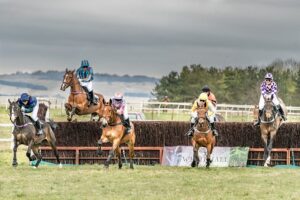Hambelton is a village in North Yorkshire, North East England, approximately seven miles east of Thirsk and half a mile east of Sutton Bank, a.k.a. Roulston Scar, which is the highest point in the Hambleton Hills, with an elevation of approximately 1,000 feet. The earliest written of horse racing in the vicinity of Hambleton, or ‘Black Hambleton’, as it was sometimes known, dates back to 1612, which was a decade before the first authenticated took place at Newmarket.
Indeed, Hambleton was, in its heyday, arguably the best racecourse in the country and received royal patronage, from Queen Anne, until her death in 1714. The Queen Anne Cup – later retitled His Majesty’s Gold Cup, following the accession of King George I in 1714 – was contested by horses aged five years and upwards, at level weights, of 10 stone, over a four-mile circuit and was the principal race of the year at Hambledon Racecourse. Ultimately, though, the location of Hambleton Racecourse and its general inaccessibility proved its undoing; the final meeting took place during the summer of 1811. Thereafter, the course became, and still is, a training ground, nowadays utilised by local trainers Kevin Ryan and Bryan Smart.
To modern racing enthusiasts, the name ‘Hambleton’ is probably most familiar from the title of the Hambleton Cup Handicap, which is run over an extended mile and a half on ‘Ladies Day’ at Thirsk in September. Nowadays, the Hambleton Cup is a run-of-the-mill, 0-85 affair, but has been run at Thirsk since the course was established in 1855 and its history dates back to 1714 at Hambleton Racecourse, from whence it takes its name; it is, in fact, one of the oldest races in the country.

 I haven’t been to lots of racecourses. In fact, I can probably count them on one hand. Huntindon, Kempton (when it was still turf), Leicester, Fakenham and Yarmouth.
I haven’t been to lots of racecourses. In fact, I can probably count them on one hand. Huntindon, Kempton (when it was still turf), Leicester, Fakenham and Yarmouth. Under Rule (F) 41.4 of the Rules of Racing, as maintained by the British Horseracing Authority (BHA), the minimum distance allowed for hurdle and steeplechase races is two miles. Traditionally, the distance of these races was rounded to the nearest half furlong, such that courses measuring 1 mile, 7 furlongs and 166 yards or more satisfied this requirement.
Under Rule (F) 41.4 of the Rules of Racing, as maintained by the British Horseracing Authority (BHA), the minimum distance allowed for hurdle and steeplechase races is two miles. Traditionally, the distance of these races was rounded to the nearest half furlong, such that courses measuring 1 mile, 7 furlongs and 166 yards or more satisfied this requirement. Situated in the Royal County of Berkshire in South East England, adjoining Windsor Great Park, Ascot is arguably the most famous racecourse in Britain, if not the world. Since 2015, Ascot has been home to 13, or 36%, of the 36 Group 1 races in the British Flat racing calendar, eight of which are run during the celebrated, five-day ‘Royal Ascot’ meeting, staged annually in June.
Situated in the Royal County of Berkshire in South East England, adjoining Windsor Great Park, Ascot is arguably the most famous racecourse in Britain, if not the world. Since 2015, Ascot has been home to 13, or 36%, of the 36 Group 1 races in the British Flat racing calendar, eight of which are run during the celebrated, five-day ‘Royal Ascot’ meeting, staged annually in June.